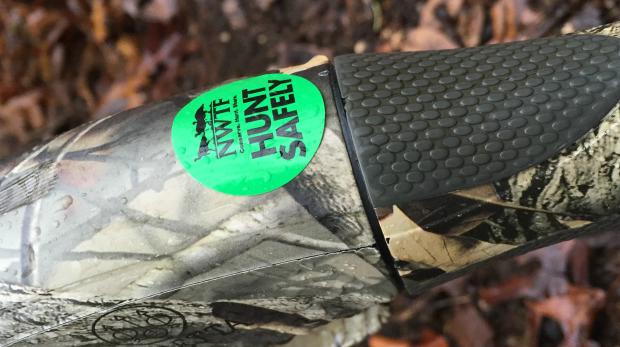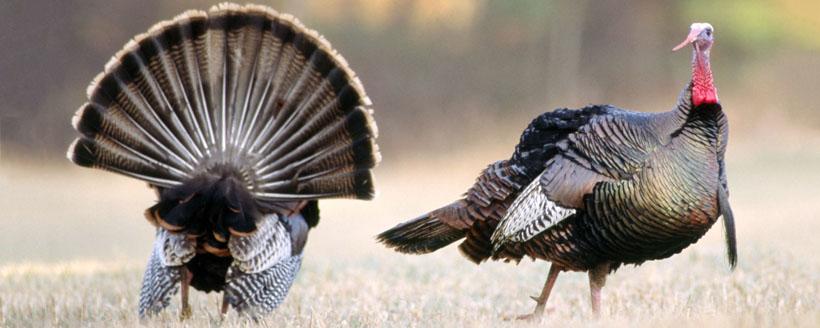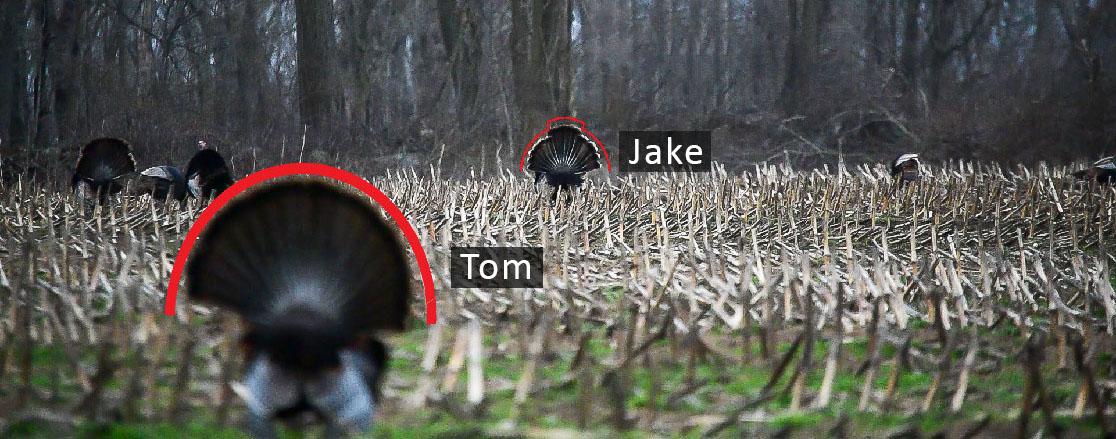Spring turkey hunting
Video: Massachusetts turkey hunting regulations
Skip this video Massachusetts turkey hunting regulations.Hunting Hours on Youth Turkey Hunting Day
Youth Turkey Day hunting hours begin 1/2 hour before sunrise and end at 5:00 p.m.
(On all other days of the spring turkey season, hunting hours begin 1/2 hour before sunrise and end at noon)
Required license, permits and safety sticker
To hunt turkey in Massachusetts on Youth Turkey Day, you must obtain the appropriate license and permits through MassFishHunt after meeting mandatory requirements.
Participants ages 12-14 must:
- Have a government-issued Basic Hunter Education certificate of completion
- Have a youth turkey permit
- Have a safety sticker*
- Be accompanied by a licensed adult (age 18+) mentor with a valid Massachusetts hunting or sporting license, a turkey permit, and any permits required to possess a firearm if the minor is hunting with a shotgun.
Participants ages 15-17 must:
- Have a government-issued Basic Hunter Education certificate of completion
- Have a minor hunting license
- Have a regular turkey permit
- Have a youth turkey day eligibility
- Have a Firearms Identification Card (FID) if hunting with a shotgun
- Have a safety sticker*
- Be accompanied by a licensed adult (age 18+) mentor with a valid Massachusetts hunting or sporting license and their own turkey permit
*If you hunt turkey with a shotgun or muzzleloader, you must place an official safety sticker on your gun. The sticker must be visible when you are sighting down the barrel.
For a new or replacement sticker, visit a MassWildlife office or send a self-addressed stamped envelope to:
MassWildlife
ATTN: Turkey safety sticker
1 Rabbit Hill Road
Westborough, MA 01581
Bag limit
Spring season: 2 bearded birds (2 birds may be harvested on the same day)
Tips for identifying turkeys in the spring
Hunting implements (spring season)
- Shotgun: No larger than 10 gauge. No larger than #4 size shot.
- Muzzleloader: No larger than .775 caliber smoothbore muzzleloading shotgun. No larger than #4 shot.
- Archery equipment: All bows must have a draw weight of at least 40lbs at 28 inches or at peak draw. Arrows must have a well sharpened steel broadhead blades not less than 7/8 inches in width. Expanding broadheads and mechanical releases are legal. Crossbows may be used by certain permitted disabled hunters. Airbows are prohibited.
If you hunt turkey with a shotgun or muzzleloader, you must place an official safety sticker on your gun. The sticker must be visible when you are sighting down the barrel.
Tagging, transporting, and reporting requirements
- You must report your game within 48 hours of harvest.
- Fill out and attach the paper tag from your permit on the carcass immediately after harvesting a turkey.
- The game must remain intact, with the tag attached, until reported and prepared for food or taxidermy.
- Report your harvest at an official check station or online.
- If you report online, write your confirmation number on the harvest tag attached to the carcass.
Hunting methods
Licensed turkey hunters may call turkeys for other hunters. Callers cannot carry firearms or archery equipment after having taken a season limit of turkeys. Callers must possess a valid license and turkey permit, even if tags are no longer attached. Mentors on Youth Turkey Hunt day are able to call for their mentee.
It is illegal to hunt turkeys using any of the following:
- Electronic calls
- Dogs
- Bait
- Drive/herd turkeys
- Live decoys
- Wanton waste
Click here to learn more about wild turkey hunting regulations, including regulations for fall.
Shooting
Sighting in your firearm and placing your shot
Patterning your shotgun before the season is critical to determine which brand of ammunition and which shot size will work best for your firearm at various ranges. Different combinations of ammunition, firearms, and chokes will produce different patterns. Hunters must identify the distance/range from which to shoot to produce a clean pattern to ethically harvest a turkey. To complete the online youth turkey program, you must go to a range and practice sighting in your hunting implement for turkey season. Review the tips below before you go to a range.
Safety
Remember the 10 basic rules of firearms safety to stay safe:
- Treat every firearm as if it is loaded.
- Keep the muzzle pointed in a safe direction. Keep the action open and unloaded. Keep the safety “on” and your finger off the trigger.
- Keep the barrel of the firearm clear of obstructions. Check the chamber and magazine every time you pick it up. Only carry and use ammunition appropriate for your firearm.
- Never point a firearm at anything you do not intend to shoot. Agree to safe fields of fire for yourself and hunting companions and never swing beyond your area.
- Positively identify your target and what lies beyond. Make sure there is an adequate backstop when hunting or target practicing.
- Unload your firearm when climbing a tree, crossing a fence, jumping a ditch, or traversing slippery or steep terrain. Never pull a firearm toward you by the muzzle.
- Be aware of the potential for ricochet. Never shoot at a hard, flat surface or water.
- Unload firearms when not in use, leaving the action open. Transport and carry firearms unloaded and cased when traveling to and from the field or target practice.
- Store firearms and ammunition separately in locked compartments and beyond the reach of children.
- Never use alcohol or drugs that can impair your judgment before or while shooting.
Eye and ear protection
When on the range, it is essential to wear earmuffs, earplugs, or some other hearing protection and safety glasses to protect both your eyes and ears.
Identifying your target
Make sure to always identify your target and what’s beyond it prior to taking a shot.
In spring you must be able to identify if a turkey has a beard, because only bearded birds may be harvested. Adult male eastern wild turkeys are black or blackish-bronze with white wing bars, blackish-brown tail feathers, and a blueish-gray to red head. These “toms” weigh about 16–25 pounds. They typically sport a 6–10 inch hair-like “beard” which protrudes from the upper chest. When a tom is strutting, its head turns bright red, pale white, or vibrant shades of blue. The tail feathers of an adult male are all the same length forming a smooth semi-circle.
Juvenile male turkeys are called Jakes and weigh about 12–16 pounds. They are black or blackish-bronze with white wing bars, blackish-brown tail feathers and a blueish-gray to red head. Jakes have small beards ranging from barely visible to 6 inches long. When a Jake struts, there are several feathers in the center of the tail fan that extend longer than the rest creating a “step” in the top center of the fan.
Females, called hens, are about 9–12 pounds, and are generally less conspicuous. Their heads are typically dull brown or blueish-gray. Although rare, female turkeys can have beards. Bearded female turkeys are legal for harvest.
Shot placement
To ethically harvest a turkey, aim for the head and neck. This ensures a quick clean kill and helps keep any pellets out of the meat.
It’s important to practice on a range to know what your effective distance is for shooting. Depending on your firearm and ammunition, some hunters can effectively shoot up to 40 yards away. Turkey hunters should never aim further than 40 yards away. New hunters should aim between 20-25 yards.
Video: Turkey hunting shooting safety video
Skip this video Turkey hunting shooting safety video.Firearms, chokes, and ammunition
When turkey hunting in Massachusetts you can use any of the three hunting implements listed below:
- Shotgun: No larger than 10 gauge. No larger than #4 size shot.
- Muzzleloader: No larger than .775 caliber smoothbore muzzleloading shotgun. No larger than #4 shot.
- Archery equipment: Bows must have a draw weight of at least 40lbs at 28 inches or at peak draw. Arrows must have well-sharpened steel broadhead blades not less than 7/8 inches in width. Expanding broadheads and mechanical releases are legal. Crossbows may be used by certain permitted disabled hunters. Airbows are prohibited.
This program focuses on using a shotgun, but if you are interested in hunting with archery equipment, please read these bowhunting turkey tips
If you're hunting turkey with a shotgun or muzzleloader, an official safety sticker must placed on the gun. The sticker must be visible when you are sighting down the barrel. For a new or replacement sticker, visit any MassWildlife office or send a self-addressed stamped envelope to:
MassWildlife
ATTN: Turkey safety sticker
1 Rabbit Hill Road
Westborough, MA 01581
Video: preparing for the range - youth turkey hunt program
Skip this video preparing for the range - youth turkey hunt program.Chokes, ammunition, and sights
Once you have your shotgun, the next step is determining the best choke, shot size and brand. It’s very important that hunters experiment with choke and ammunition to find the right combination for your firearms. Different loads, sizes, or manufactures will not fire the same pattern. Remember, whenever you are handling a firearm, you want to always make sure that your firearm is unloaded with the action open and safety is on.
Shot size: You will want to make sure you are using a turkey load no greater than #4. Commonly, hunters use turkey loads between #4-#6 size shot.
Choke: The purpose of the choke is to narrow the bore diameter to create a tighter pattern. The two most common types of chokes used for turkey hunting are full or extra full chokes.
Sights: Sights can range from a “bead” on the end of the firearm to a scope. For turkey hunting, generally either a bead that is found on the end of the barrel or fiber-optic sights, are most common. Sights are not necessary and should only be used if they improve your accuracy.
Patterning your shotgun before the season is critical to determine which brand of ammunition and which shot size will work best for your firearm at various ranges. Different combinations of ammunition, firearms, and chokes will produce different patterns. All hunters must identify the distance/range from which you can shoot that produces a clean pattern to ethically harvest a turkey.
Thank you to our partners at the National Wild Turkey Federation for creating and sharing these fantastic videos. For more turkey hunting videos you can visit tv.nwtf.org.
Safety
Review these tips regularly for a safe and fun wild turkey hunting season.
Wild turkeys have excellent eyesight and can easily detect movement and colors that are out of place in the woods, making complete camouflage or drab colored clothing very important. Camouflage not only reduces the turkey's chance of seeing you, but also has the same effect on other hunters. Most turkey hunting accidents occur when hunters sneak up on (stalk) other hunters who are calling. To have a safe and successful hunt, remember these tips:
Tips for decoy placement
Decoys can be an effective tool for helping bring a turkey into range. It’s important when setting out decoys to make sure your placement keeps you safe. Below are some general tips for hunting safely with decoys.
- In a field setting, decoys should be placed about 10-15 yards away from where you are sitting. If you have an idea of the direction turkeys will approach from, offset the decoys to one side as turkeys are famous for “hanging-up” just yards out of range.
- Always place the decoys to your side rather than straight in front of you. If you are right-handed, set the decoys to your left, to the right if you are left-handed.
- Use decoys that are easy to fold up and store concealed in your vest or a pack for easy and safe transport from location to location.
- When moving in the woods, conceal your decoys in a vest or bag so that another hunter doesn’t mistake them for a real bird.
Tips for shot placement
- Be completely sure of your target and what is beyond it before you shoot.
- Always practice the 10 commandments of firearm safety and make sure to shoot/pattern your shotgun before the season.
- Know your effective range and bring a rangefinder when you hunt. Range several objects upon setting up so you don’t shoot beyond your effective range.
General safety tips
- If you hear hen calls like yelps and purrs don’t stalk them. It could be another hunter. Never stalk a turkey, sit and make sure to call the bird to you.
- Do not wear red, white, blue, or black; these colors are associated with male turkeys.
- Consider wearing hunter orange when entering or leaving your hunting area.
- Protect your back. Set up against a large tree or rack and make sure your view isn't obstructed. Don't hide in a place with an obstructed view.
- During the mentored hunt you will want your mentor sitting within arm’s reach of you.
- Be still. Turkeys have incredible eyesight and can see movement very well. Hunting from a blind can help conceal movement. If you are not in a blind, try to be ready with your firearm resting on your knee or use a shooting stick to support the gun. When a turkey comes into view you don’t want to move any more than just turning off your safety and squeezing the trigger.
- Be comfortable! It is important to make sure you are comfortable because that will help you stay still for a longer period. This mean dressing appropriately for the weather and having a comfortable chair or cushion to sit on.
- Respect other hunters. Don't approach areas where other hunters are working birds. Don't get between another hunter and a bird.
- Keep good visibility so you can see turkeys and other hunters approaching your position. Some hunters tie bright survey tape to a branch above their position to alert other hunters of their presence.
- If using a turkey blind put a piece of orange flagging at the top of your blind or on a branch above it so other hunters in the area know you are there.
- If another hunter does approach your position, remain still and call out to the hunter in a loud voice. Do not wave or use your turkey call to get another hunter's attention.
Next steps
Once you have reviewed the content on this page, you need to take more steps to complete the Youth Turkey Program:
- Complete the Massachusetts Online Youth Turkey Seminar
This part of the seminar teaches turkey hunting tips and strategies, hunting locations, and shotguns for turkey hunting. This free training is hosted by “Today’s Hunter” with resources from the National Wild Turkey Federation. You will be prompted to create an account before taking this course. Be sure to enter accurate information about the youth hunter since proof of seminar completion will trigger hunt eligibility in the MassFishHunt licensing system. Start module now.
*Note: When you finish the online seminar, it’s time to practice at the range. The last step in the online seminar asks you to affirm that you have completed all requirements—including range practice—so you’ll need to log out and return when this is completed. Your work will be saved.
- Go to a range and practice
Practice sighting in with the firearm you plan to use on the Youth Turkey Hunt while practicing the 10 basic rules of firearms safety.
- Affirm completion of steps
Once you have completed the Massachusetts Turkey Regulation Module, the Online Youth Turkey Seminar, and the range practice, log back into the online seminar and affirm. Click here to log back into the seminar and complete the process. You will receive a confirmation email within 24 hours of completing the seminar. Once you have received the email (and completed Basic Hunter Education) you can get your turkey permit/hunt eligibility.



